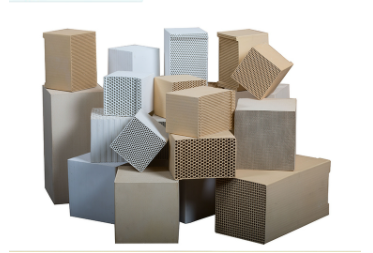Newest Rto Cellular Ceramic Regenerator
2025-10-14
Product Introduction
Cellular ceramics have a large specific surface area, low fluid resistance, high temperature resistance, corrosion resistance, low thermal expansion coefficient, and high strength. Main uses: 1. Catalyst carrier, used for purifying industrial waste gas and automobile/motorcycle exhaust. 2. Heat exchange medium: used as a heat storage body in steel, chemical, and building materials industries, saving 12%. 3. Fixed biological carrier: used in pharmaceutical and food industries for microbial fixation and filtration devices. 4. Gas combustion distribution plate: promotes complete combustion, saving 12%. 5. Tower packing.
Product Features
1. Has a large specific surface area: specific surface area ≧ 1800m2/g;
2. Has good selective adsorption performance: different molecular sieves are formulated for different waste gas sources, components, and proportions.
3. Large adsorption capacity, adsorption amount reaches 20-40%;
4. Has good mechanical strength: product longitudinal compressive strength 1.0Mpa, transverse compressive strength 0.8Mpa;
5. Has sufficient thermal stability and chemical stability: product is temperature resistant and can be regenerated at high temperature;
6. Good regeneration ability: product can be regenerated at high temperature, regeneration efficiency can reach 99.9%, service life can reach 5 years.
Product Application Fields
As a catalyst carrier, mainly used for automobile exhaust purification, air deodorization, etc., such as automobile exhaust catalytic converters.
As a filter body, mainly used in food, environmental protection, metallurgy and other industries, for filtering particles in gases, impurities or bubbles in molten metals, and dust filtration in various industrial waste gases.
Technical Parameters
Material | Shape and Size | Compressive Strength | Thermal Expansion Coefficient | Maximum Operating Temperature | Thermal Shock Resistance | Corrosion Resistance |
High alumina ceramics, cordierite, porous mullite ceramics, etc. | Square, triangular, honeycomb shapes | Axial > 712Mpa Radial >4.5Mpa | 1-2 ×10 -6 /℃
| 1500 ℃ | 900 ℃
| Strong |
At the heart of every high-performance Regenerative Thermal Oxidizer lies the critical RTO Cellular Ceramic Regenerator. This ingenious component is the key to achieving unparalleled thermal efficiency, often surpassing 95% in well-designed systems. Its role is to sequentially capture heat from purified exhaust and then release it to incoming, polluted process streams. This cyclic energy recovery process is what makes RTO technology both economically and environmentally superior for volatile organic compound (VOC) destruction.

The physical design of the RTO Cellular Ceramic Regenerator is a marvel of chemical engineering. It is manufactured as a monolithic block featuring a dense, honeycomb-like cellular structure. This configuration maximizes the surface area available for heat exchange while maintaining a low resistance to gas flow, which helps to minimize system pressure drop. The ceramic material is selected for its exceptional thermal stability, high heat capacity, and resistance to thermal shock, ensuring durability.
The entire RTO process is built around the dual-function capability of the RTO Cellular Ceramic Regenerator. One section of the media bed is heated by the outgoing clean gas, storing thermal energy. When the flow direction reverses, the incoming contaminated air is forced through this hot section. The ceramic media instantly transfers its stored heat, preheating the air before it enters the combustion chamber, which significantly reduces the fuel required to maintain the necessary oxidation temperature.
The selection of an appropriate RTO Cellular Ceramic Regenerator is paramount for long-term system reliability and cost control. Its superior heat recovery capability leads to direct savings on natural gas or other fuels. This not only improves your bottom line but also enhances your plant's environmental stewardship by conserving energy. Ultimately, the performance and longevity of your RTO are directly dependent on the quality and design of this vital regenerative component.
Recommended News




